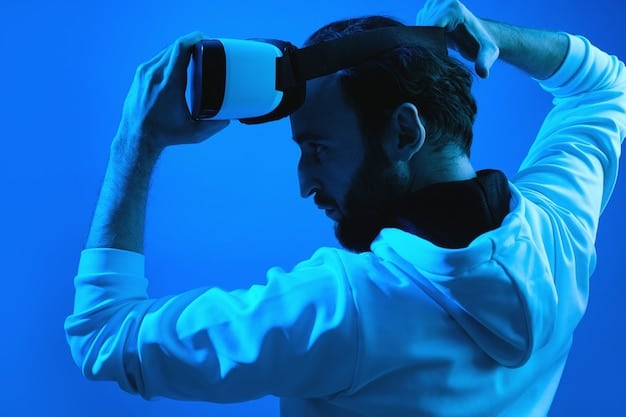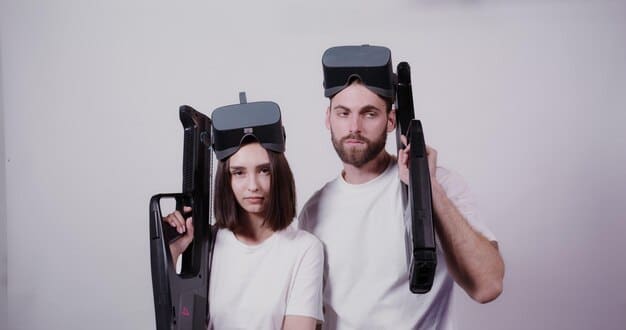Are XR Headsets Worth the Extra Cost? A Deep Dive

Extended Reality (XR) headsets offer immersive experiences, but their price premium compared to standard VR devices raises the question: are the advanced features and enhanced capabilities truly worth the additional investment for the average user or are they only suitable for professionals?
The allure of Extended Reality (XR) headsets is undeniable, promising a blend of virtual and augmented realities that can transform gaming, education, and even workplace interactions. But do these advanced features justify the often hefty 30% price premium over traditional VR headsets? Let’s delve into a comprehensive comparison to help you decide if the upgrade is right for you.
Understanding Extended Reality (XR) Headsets
Extended Reality (XR) is an umbrella term encompassing Virtual Reality (VR), Augmented Reality (AR), and Mixed Reality (MR). XR headsets aim to provide a more versatile and immersive experience than standard VR devices. But what exactly differentiates them?
XR headsets typically boast enhanced processing power, higher resolution displays, and more advanced tracking capabilities compared to their VR counterparts. This allows for more realistic and interactive experiences across a wider range of applications.
Key Differences Between XR and VR Headsets
While both VR and XR headsets offer immersive experiences, the technology behind them differs significantly.
- Tracking Capabilities: XR headsets often feature more advanced tracking systems, such as simultaneous localization and mapping (SLAM), allowing for precise movement and interaction within the virtual or mixed reality environment.
- Display Technology: XR headsets generally utilize higher resolution displays and wider fields of view to enhance visual fidelity and immersion.
- Processing Power: XR devices tend to have more powerful processors to handle the complex computations required for rendering realistic and interactive XR experiences.
- Application Versatility: XR headsets are designed for a broader range of applications, including gaming, training simulations, remote collaboration, and industrial design, making them more versatile than VR headsets primarily focused on entertainment.

In summary, XR headsets represent a significant step forward in immersive technology, offering enhanced capabilities and versatility compared to traditional VR headsets. Whether these advancements justify the price premium depends on your specific needs and use cases.
Analyzing the Price Premium: What Are You Paying For?
The 30% price premium associated with XR headsets reflects the advanced components and sophisticated engineering that go into these devices. Let’s break down the specific factors that contribute to the higher cost.
It’s essential to understand what drives the cost of XR headsets to determine if the added expense aligns with the value you seek in an immersive experience.
Factors Contributing to the Price Premium
Several factors contribute to the higher price of XR headsets including advanced technology and hardware components.
- Advanced Sensors and Tracking: XR headsets need to have advanced sensors and tracking capabilities for a better experience. This included SLAM which allows more accurate navigation.
- High-Resolution Displays: XR headsets normally come with better screens, which increases the cost.
- More powerful processors: XR headsets need to preform complex computations for realistic experiences, so they have more powerful (and expensive) processors to accomplish this.
Ultimately, the specific features that drive up the cost of XR headsets contribute to the value for specific use cases.
Use Cases Where XR Headsets Shine
XR headsets offer unique capabilities that make them particularly well-suited for specific applications. Understanding these use cases can help determine if the price premium is justified for your needs.
From professional training to cutting-edge entertainment, XR headsets are transforming various industries.

Examples of XR Applications
From gaming to professional training, XR headsets have unique applications.
- Enterprise Training: XR headsets provide realistic and immersive training simulations for industries such as healthcare, manufacturing, and aerospace, improving skill retention and safety.
- Remote Collaboration: XR headsets can facilitate more engaging and productive remote meetings, allowing participants to interact with 3D models and virtual environments as if they were in the same location.
- Medical Visualization: XR technology enables medical professionals to visualize complex anatomical structures in 3D, enhancing surgical planning and patient education.
- Industrial and Architectural Design: XR headsets empower designers and engineers to visualize and iterate on product designs and architectural plans in a highly intuitive and collaborative manner.
In conclusion, the unique capabilities of XR headsets make them invaluable in various applications, driving innovation and improving outcomes across diverse industries.
The User Experience: Is It Significantly Better?
Beyond the technical specifications, the ultimate measure of an XR headset’s worth lies in the user experience it delivers. Does the enhanced technology translate to a noticeably superior immersive experience?
While subjective, the user experience is often the deciding factor for consumers weighing the price premium.
Aspects of the User Experience
XR headsets offer many things that improve the value and user experience for the customer. For some, this can greatly enhance their feelings regarding VR overall too.
- Immersion: The higher resolution displays and wider field of view contribute to a more realistic and immersive visual experience.
- Interactivity: Advanced tracking capabilities enable more precise and intuitive interaction with the virtual or mixed reality environment.
- Comfort: While comfort varies across models, some XR headsets are designed with improved ergonomics for extended use.
- Versatility: The ability to seamlessly switch between VR, AR, and MR experiences provides a more versatile and engaging user experience.
The improved user experience offered by XR headsets can justify the price premium for users that are looking for the full package, otherwise, it might not be worth it.
Weighing the Pros and Cons: Making the Right Choice
Ultimately, deciding whether an XR headset is worth the 30% price premium requires careful consideration of your individual needs and priorities. Let’s weigh the pros and cons to help you make an informed decision.
By balancing the benefits and drawbacks, you can determine if the investment aligns with your desired immersive experience.
Consider These Points
Several considerations can help you decide what is best for you.
- Budget: Can you comfortably afford the price premium without straining your finances?
- Intended Use: Will you be using the headset for applications that benefit from XR’s advanced features, such as professional training or collaborative design?
- Technological Requirements: Do you have the necessary computing power to support the demands of XR experiences?
Hopefully this is enough information for you to make a more informed decision.
Future Trends in XR Headset Technology
The world of XR is rapidly evolving, with new advancements constantly emerging. Understanding these future trends can inform your decision-making process, as today’s premium features may become standard in tomorrow’s headsets.
Anticipating future developments can help you determine if waiting for the next generation of devices is a better strategy.
Trends to Watch
The XR market is always changing, so here are 3 things to keep in mind.
- Increased Resolution and Refresh Rates: Future XR headsets will likely feature even higher resolution displays and faster refresh rates, further enhancing visual fidelity and reducing motion sickness.
- Improved Wireless Connectivity: Wireless XR headsets will become more prevalent, offering greater freedom of movement and ease of use.
- Integration of AI and Machine Learning: AI-powered XR headsets will be capable of more intelligent and personalized experiences, adapting to user behavior and preferences.
Staying informed about these trends can empower you to make a purchase decision that aligns with your long-term needs and the evolving landscape of XR technology.
| Key Point | Brief Description |
|---|---|
| 🚀 Enhanced Immersion | Higher resolution and wider field of view for better visuals. |
| 🎯 Precise Tracking | Advanced sensors provide more accurate movement tracking. |
| 💼 Versatile Applications | Suitable for gaming, training, collaboration, and design. |
| 💰 Price Consideration | Assess if the benefits justify the 30% premium. |
Frequently Asked Questions About XR Headsets
▼
An XR headset is an umbrella term for devices that offer Virtual Reality (VR), Augmented Reality (AR), and Mixed Reality (MR) experiences, providing a blend of digital and real-world interactions for more versatile uses than standard VR headsets.
▼
XR headsets offer superior tracking capabilities, higher-resolution displays, more powerful processors, and greater versatility in applications compared to VR headsets that primarily focus on gaming and entertainment.
▼
Comfort levels vary among different XR headset models, but some models are designed with improved ergonomics to provide greater comfort during prolonged use. User tests and reviews can provide more specific fit feedback.
▼
Beyond gaming, XR headsets are used in enterprise training, remote collaboration, medical visualization, architectural design, and other fields to improve skill retention, productivity, surgical planning, and design workflows.
▼
Future XR headsets are expected to feature higher resolutions and refresh rates, improved wireless connectivity, and incorporate AI/machine learning to offer more intelligent and personalized experiences.
Conclusion
Ultimately, the decision of whether Extended Reality (XR) headsets are worth the 30% price premium rests on your specific needs and intended use cases. If you require advanced tracking, higher resolution displays, and versatility for applications like professional training or collaborative design, the investment may be well justified. However, if your primary focus is gaming or basic VR experiences, a standard VR headset might suffice. Carefully weigh the pros and cons to make an informed decision that aligns with your budget and desired immersive experience.





